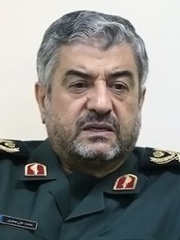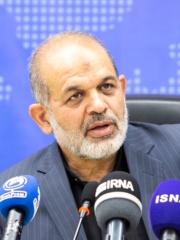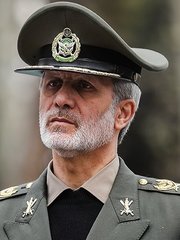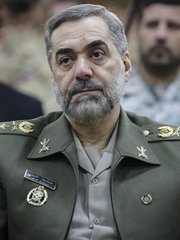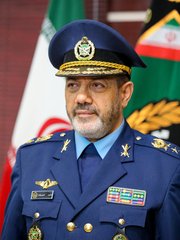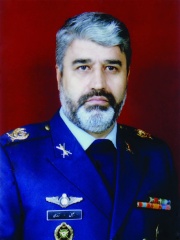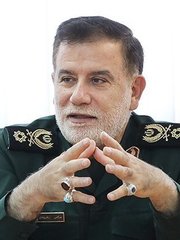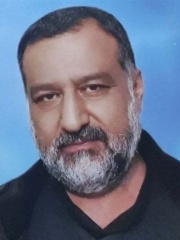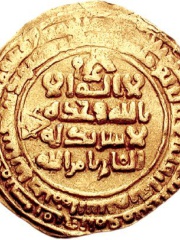
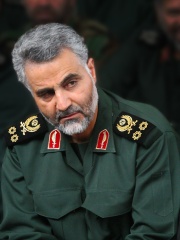
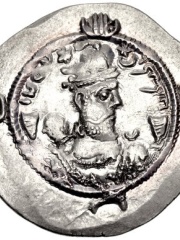
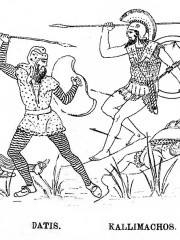
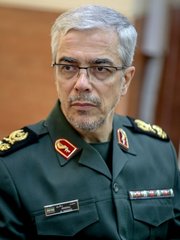
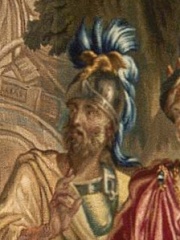
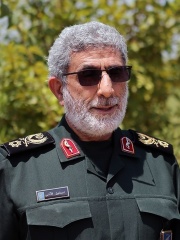
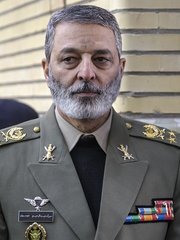
The Most Famous
MILITARY PERSONNELS from Iran
This page contains a list of the greatest Iranian Military Personnels. The pantheon dataset contains 2,058 Military Personnels, 21 of which were born in Iran. This makes Iran the birth place of the 16th most number of Military Personnels behind Austria, and India.
Top 10
The following people are considered by Pantheon to be the top 10 most legendary Iranian Military Personnels of all time. This list of famous Iranian Military Personnels is sorted by HPI (Historical Popularity Index), a metric that aggregates information on a biography's online popularity. Visit the rankings page to view the entire list of Iranian Military Personnels.

1. Tughril (990 - 1063)
With an HPI of 77.61, Tughril is the most famous Iranian Military Personnel. His biography has been translated into 50 different languages on wikipedia.
Abu Talib Muhammad Tughril ibn Mika'il (Persian: ابوطالبْ محمد طغرل بن میکائیل), better known as Tughril (طغرل / طغریل; also spelled Toghril / Tughrul), was a Turkoman chieftain, who founded the Seljuk Empire, ruling from 1037 to 1063. Tughril united many Turkoman warriors of the Central Asian steppes into a confederacy of tribes and led them in conquest of Khorasan and eastern Persia. He would later establish the Seljuk Sultanate after conquering Persia and taking the Abbasid capital of Baghdad from the Buyids in 1055. Tughril relegated the Abbasid Caliphs to state figureheads and took command of the caliphate's armies in military offensives against the Byzantine Empire and the Fatimids in an effort to expand his empire's borders and unite the Islamic world. After the deaths of Seljuk leaders such as Israil and Mikail, the Seljuks submitted to the authority of Tughril Bey and began expanding their territories under the leadership of his brother, Chaghri Beg. In 1037, Tughril was declared sultan by the prominent figures of the Seljuk dynasty, and a sermon (khutbah) was delivered in his name. Following the death of Mahmud of Ghazni and the accession of Sultan Masʽud, the Seljuks, under Tughril’s leadership, engaged in several phases of warfare with the Ghaznavids. As a result, the Seljuks emerged as a new power in the Middle East after their decisive victory in the Battle of Dandanqan in 1040, which brought an end to Ghaznavid rule in Greater Khorasan and surrounding regions. Subsequently, Tughril settled in Nishapur as his capital and, with the support of his brother and close allies, established his own state. Following the Battle of Dandanaqan, Tughril, along with the Seljuk leadership, sent a letter to the Abbasid caliph al-Qa'im bi-Amrillah, requesting an official decree of authority, which was granted. Between the Hijri years 1040–1054, with the assistance of Ibrahim Inal, Tughril conquered large parts of Iranian territory, including the regions of Jibal and Iraq-i Ajam, and brought an end to the Buyid government in these areas. He captured the city of Ray, restored it, and declared it the capital. However, after capturing Isfahan, he moved the capital there. Later, Tughril brought Azerbaijan under his control and carried out military campaigns against Byzantium and other regions of Eastern Roman territories, further expanding the Seljuk realm. In 1055, accepting an invitation from the Abbasid caliph to visit Baghdad, Tughril initiated a new phase in Seljuk–Abbasid relations. Between 1055–1061, he eliminated Buyid rule in Baghdad, captured Malik Rahim, and had sermons read in his name in those territories. After restoring Baghdad, Tughril arranged the marriage of Chaghri Beg’s daughter to the Abbasid caliph, thus strengthening ties with the caliphate. He subsequently seized the Jazira region. Later, after suppressing a revolt by his brother Ibrahim Inal and executing him, Tughril also defeated Arslan al-Basasiri, who had the backing of the Fatimid Caliphate. He married the caliph’s daughter despite opposition from the caliph himself—a union that was accompanied by numerous challenges. Ultimately, in 1063, Tughril died without leaving an heir and left behind a vast empire. Tughril Beg was known as a devout figure and commissioned the construction of many mosques and madrasas. He was recognized for his adherence to the Hanafi school of Islamic jurisprudence and, with the assistance of his vizier Amid al-Mulk Kunduri, imposed restrictions on the activities of other Islamic sects. While some sources describe him as a just ruler who avoided unnecessary bloodshed, other accounts report oppressive conduct by him and his army. Tughril’s legacy was the administrative model he created, which was composed of the Turkic political tradition, the region’s customary administrative principles, and the religious legitimacy derived from the Abbasid Caliphate. This model reshaped the institution of sultanate into a form of absolute rule endowed with extraordinary authority. This form of rule overshadowed the worldly power of the caliph, recognizing only his spiritual leadership. Consequently, the caliph was compelled to submit to Tughril’s demands. Before the advent of the Seljuks, Iran was divided between several warring local powers, such as the Buyids, Kakuyids and Ghaznavids. As a result, it suffered from continuous war and destruction. However, under Tughril peace and prosperity were brought to the country and to Mesopotamia, a transition that was further reinforced due to the Seljuks' assimilation to Iranian-Muslim culture.

2. Qasem Soleimani (1957 - 2020)
With an HPI of 69.10, Qasem Soleimani is the 2nd most famous Iranian Military Personnel. His biography has been translated into 82 different languages.
Qasem Soleimani (Persian: قاسم سلیمانی, romanized: Qâsem Soleymâni; 11 March 1957 – 3 January 2020) was an Iranian military officer who served in the Islamic Revolutionary Guard Corps (IRGC). From 1998 until his assassination by the United States in 2020, he was the commander of the Quds Force, an IRGC division primarily responsible for extraterritorial and clandestine military operations, and played a key role in the Syrian civil war through securing Russian intervention. He was described as "the single most powerful operative in the Middle East" and a "genius of asymmetric warfare". Former Mossad director Yossi Cohen said Soleimani's strategies had "personally tightened a noose around Israel's neck". In his later years, he was considered by some analysts to be the right-hand man of the supreme leader of Iran, Ali Khamenei, and the second-most powerful person in Iran behind Khamenei. For attacks orchestrated or attempted against Americans and other targets abroad, Soleimani was personally sanctioned by the United Nations and the European Union, and was designated as a terrorist by the United States in 2005. Soleimani was assassinated by a targeted drone strike on 3 January 2020 in Baghdad, Iraq. Iranian government officials publicly mourned Soleimani's death and launched missiles against U.S. military bases in Iraq, wounding 110 American troops. Iranian outlets subsequently represented Soleimani as a national hero.

3. Bahram Chobin (600 - 592)
With an HPI of 67.87, Bahram Chobin is the 3rd most famous Iranian Military Personnel. His biography has been translated into 41 different languages.
Bahrām Chōbīn (Persian: بهرام چوبین) or Wahrām Chōbēn (died 591), also known by his epithet Mehrbandak ("servant of Mithra"), was a nobleman, general, and political leader of the late Sasanian Empire and briefly its ruler as Bahram VI (Middle Persian: 𐭥𐭫𐭧𐭫𐭠𐭭, r. 590–591). Son of general Bahram Gushnasp and hailing from the noble House of Mihran, Bahram began his career as the governor of Ray, and was promoted to the army chief (spahbed) of the northwestern portions of the empire after capturing the Byzantine stronghold of Dara, fighting in the war of 572–591. After a massive Hephthalite-Turkic invasion of the eastern Sasanian domains in 588, he was appointed as the spahbed in Khorasan, beginning a campaign that ended in a decisive Iranian victory. Bahram earned an elevated position in Iran due to his noble descent, character, skills, and accomplishments. The Sasanian king (shah) Hormizd IV (r. 579–590) was already distrustful of Bahram and stripped the increasingly popular general of his commands. Bahram began a rebellion aiming to reestablish the "more rightful" Arsacid Empire, identifying himself with the promised savior of the Zoroastrian faith. Before he had reached the Sasanian capital of Ctesiphon, Hormizd was assassinated in support of his son, Khosrow II, by another anti-Hormizd faction led by the two Ispahbudhan brothers, Vistahm and Vinduyih. As Bahram captured Ctesiphon, Khosrow II fled to the Byzantine Empire, with the assistance of which he launched a campaign against Bahram. Bahram's outnumbered forces were defeated, but he managed to flee to the Western Turkic Khaganate where he was well received. He was assassinated shortly thereafter at the instigation of Khosrow II, who was then the shah. Bahram Chobin's legacy survived even after the Arab conquest of Iran among Iranian nationalists, as well as in Persian literature.

4. Datis (600 BC - 490 BC)
With an HPI of 66.69, Datis is the 4th most famous Iranian Military Personnel. His biography has been translated into 30 different languages.
Datis or Datus (Greek: Δάτης, Old Iranian: *Dātiya-, Achaemenid Elamite: Da-ti-ya) was a Median noble and admiral who served the Persian Empire during the reign of Darius the Great (522–486 BC). He is known for his role in leading the Persian amphibious expedition against Greece in 490 BC during the Greco-Persian Wars. Along with Darius's nephew Artaphernes, he was tasked with subduing Eretria and Athens, succeeding the previously defeated Mardonius. While some later sources claim Datis died during the Battle of Marathon (490), this is not corroborated by other evidence. His later career is largely unknown except that his sons served as cavalry leaders under Xerxes I (486–465 BC). Datis was familiar with Greek affairs, maintained connections with Greek officials, respected Greek deities, and even attempted to speak Greek.
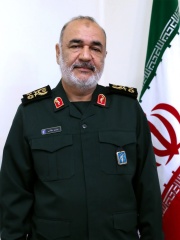
5. Hossein Salami (1960 - 2025)
With an HPI of 65.92, Hossein Salami is the 5th most famous Iranian Military Personnel. His biography has been translated into 25 different languages.
Hossein Salami (Persian: حسین سلامی; 1960 – 13 June 2025) was an Iranian military officer who served as the commander-in-chief of the Islamic Revolutionary Guard Corps (IRGC) from 2019 until 2025, when he was killed by an Israeli airstrike during the Iran–Israel war. Salami joined the IRGC during the Iran–Iraq War in 1980, when he was a college student. He rose through the ranks, becoming deputy commander. On 21 April 2019, the supreme leader of Iran, Ali Khamenei, appointed him as the new Commander-in-Chief of the IRGC, replacing major general Mohammad Ali Jafari. Salami stood out among the commanders of the IRGC for his fiery and aggressive speeches targeting the US, Israel, and Saudi Arabia.

6. Mohammad Bagheri (1960 - 2025)
With an HPI of 65.53, Mohammad Bagheri is the 6th most famous Iranian Military Personnel. His biography has been translated into 28 different languages.
Mohammad Bagheri (Persian: محمد باقری, 1960 – 13 June 2025); born Mohammad-Hossein Afshordi (محمدحسین افشردی) was an Iranian military officer in the Islamic Revolutionary Guard Corps (IRGC), who served as the Chief of Staff of the Iranian Armed Forces from 2016 to 2025. The chief of staff is considered the highest ranking military officer in the Islamic Republic of Iran and is responsible for the coordination and supervision of Iran’s regular army (Artesh) and the Islamic Revolutionary Guard Corps (IRGC). Bagheri was killed along with other senior officers during a series of airstrikes launched by Israel on 13 June 2025. He was the highest ranking military officer in Iran at the time of his death. Mohammad Bagheri was one of Iran's most prominent military commanders and served as Chief of Staff of the Armed Forces of the Islamic Republic of Iran from 2016 until his death in June 2025. He was born into a revolutionary and religious family in Tehran. He was the younger brother of Hassan Bagheri (Gholamhossein Afshordi), the founder of the IRGC's Operations Intelligence Unit. Mohammad Bagheri played a key role in strengthening Iran's defense capabilities, with more than 45 years of service in the IRGC. He was killed in the early hours of Friday, June 13, 2025, at the age of 65, following an attack on Tehran by Israel. Bagheri began his military career in 1979 with the Islamic Revolutionary Guard Corps and served during the Iran–Iraq War. From 2002 to 2014, he was the Deputy for Information and Operations of the General Staff of the Armed Forces of the Islamic Republic of Iran. Additionally, he served as the Deputy Coordinator of the Khatam ol-Anbiya Central Headquarters from 2007 to 2016. Between 2014 and 2016, he held the position of Deputy for Joint Affairs and Structures of the General Staff of the Armed Forces of the Islamic Republic of Iran. He was a lecturer at Tarbiat Modares University and a faculty member of the Supreme National Defense University of Iran. The United States Department of the Treasury placed him on its sanctions list in November 2019. The Canadian government sanctioned him for human rights violations in Iran on October 3, 2022. The European Union also sanctioned him in October 2022 for sending a drone to Russia for use in the invasion of Ukraine.

7. Harpagus (700 BC - 600 BC)
With an HPI of 65.50, Harpagus is the 7th most famous Iranian Military Personnel. His biography has been translated into 24 different languages.
Harpagus, also known as Harpagos (Ancient Greek Ἅρπαγος; Akkadian: Arbaku), was a Median general during the 6th century BC, credited by Herodotus as having put Cyrus the Great on the throne through his defection during the Battle of Pasargadae.

8. Esmail Ghaani (b. 1957)
With an HPI of 62.68, Esmail Ghaani is the 8th most famous Iranian Military Personnel. His biography has been translated into 27 different languages.
Esmail Qaani (also rendered as Ismail Qaani; Persian: اسماعیل قاآنی, romanized: Esmāʾil Qāʾānī; 8 August 1957) is an Iranian brigadier general in the Islamic Revolutionary Guard Corps (IRGC) who serves as the commander of the IRGC Quds Force, an elite special operations force responsible for extraterritorial operations. Qaani succeeded Qasem Soleimani as Quds Force commander after Soleimani was assassinated in January 2020.

9. Abdolrahim Mousavi (b. 1960)
With an HPI of 60.34, Abdolrahim Mousavi is the 9th most famous Iranian Military Personnel. His biography has been translated into 20 different languages.
Sayyid Abdolrahim Mousavi (Persian: سیّد عبدالرحیم موسوی; born 1960) is an Iranian military officer who is the chief of staff of the Iranian Armed Forces. He assumed the position following the assassination of his predecessor, Mohammad Bagheri, during the June 2025 Israeli strikes on Iran. He previously served as the chief of staff and commander-in-chief of the Iranian Army from 2017 to 2025.

10. Amir Ali Hajizadeh (1962 - 2025)
With an HPI of 60.17, Amir Ali Hajizadeh is the 10th most famous Iranian Military Personnel. His biography has been translated into 21 different languages.
Amir Ali Hajizadeh (Persian: امیرعلی حاجیزاده; 28 February 1962 – 13 June 2025) was an Iranian military officer who served as the commander of the IRGC Aerospace Forces, a position he held from October 2009 until his assassination in June 2025 by an Israeli airstrike.
People
Pantheon has 21 people classified as Iranian military personnels born between 700 BC and 1966. Of these 21, 8 (38.10%) of them are still alive today. The most famous living Iranian military personnels include Esmail Ghaani, Abdolrahim Mousavi, and Mohammad Ali Jafari. The most famous deceased Iranian military personnels include Tughril, Qasem Soleimani, and Bahram Chobin. As of April 2024, 9 new Iranian military personnels have been added to Pantheon including Mohammad Bagheri, Abdolrahim Mousavi, and Amir Ali Hajizadeh.
Living Iranian Military Personnels
Go to all RankingsEsmail Ghaani
1957 - Present
HPI: 62.68
Abdolrahim Mousavi
1960 - Present
HPI: 60.34
Mohammad Ali Jafari
1957 - Present
HPI: 59.33
Mohammad Pakpour
HPI: 58.94
Ahmad Vahidi
1958 - Present
HPI: 57.51
Amir Hatami
HPI: 54.67
Mohammad-Reza Gharaei Ashtiani
1960 - Present
HPI: 54.66
Aziz Nasirzadeh
1964 - Present
HPI: 54.32
Deceased Iranian Military Personnels
Go to all RankingsTughril
990 - 1063
HPI: 77.61
Qasem Soleimani
1957 - 2020
HPI: 69.10
Bahram Chobin
600 - 592
HPI: 67.87
Datis
600 BC - 490 BC
HPI: 66.69
Hossein Salami
1960 - 2025
HPI: 65.92
Mohammad Bagheri
1960 - 2025
HPI: 65.53
Harpagus
700 BC - 600 BC
HPI: 65.50
Amir Ali Hajizadeh
1962 - 2025
HPI: 60.17
Mohammad Reza Zahedi
1960 - 2024
HPI: 56.86
Jalil Zandi
1951 - 2001
HPI: 55.55
Abbas Nilforoushan
1966 - 2024
HPI: 51.66
Razi Mousavi
1962 - 2023
HPI: 50.61
Newly Added Iranian Military Personnels (2025)
Go to all RankingsMohammad Bagheri
1960 - 2025
HPI: 65.53
Abdolrahim Mousavi
1960 - Present
HPI: 60.34
Amir Ali Hajizadeh
1962 - 2025
HPI: 60.17
Mohammad Pakpour
HPI: 58.94
Mohammad Reza Zahedi
1960 - 2024
HPI: 56.86
Amir Hatami
HPI: 54.67
Mohammad-Reza Gharaei Ashtiani
1960 - Present
HPI: 54.66
Aziz Nasirzadeh
1964 - Present
HPI: 54.32
Abbas Nilforoushan
1966 - 2024
HPI: 51.66
Overlapping Lives
Which Military Personnels were alive at the same time? This visualization shows the lifespans of the 9 most globally memorable Military Personnels since 1700.

